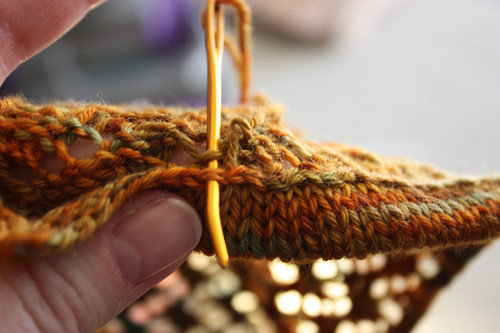"Storage" can mean just about anything: a special drawer, air tight boxes or vacuum-sealed bags, even the freezer. I'm not that fancy. My intent is the following: cleaned, thoroughly dried, nicely folded with sheets of acid free tissue paper between layers, and nicely stacked in a storage tub with sachets of lavender and cedar. In practice, they might not be as nicely folded as I thought, there may be the odd mitten or scarf thrown on top, oh THERE'S that whosamajig I couldn't find all Spring and Summer, etc.
Hopefully, you are storing your knits, particularly your beloved hand knits, during warmer weather. Store your pieces clean (critters like moths feed off the carbohydrates in the "soil" on your fiber, like the oils from your fingers), dry (to avoid mildew), with natural critter deterrents (moth balls just don't smell great) and in some sort of breathable container (the heartbreak of finding that your favorite wool sweater changed color due to lack of oxygen is ... heartbreaking).
But let's talk about taking your knits OUT of storage. In a perfect world, you have a beautifully immaculate storage system, only requiring a fluffing of your sweaters before wearing.
On to the real world.
Your storage bin of knits is halfway turned over to make more room for the Christmas ornaments and your exercise bicycle. One of your lavender sachets broke open, spilling tiny buds across all of your knits, even your floofy mohair sweater. Your knits are more than a bit rumpled and the delicate fragrance of lavender is overwhelmingly strong. Buttons are missing. And your favorite cashmere sweater, despite your best efforts, has a new cobwebby appearance thanks to a critter munching on one shoulder.
Not that any of this has ever happened to me.

Don't panic - you can easily deal with all of this. Try to set aside a weekend to take your knits out of storage. Here's what you may need:
1. Vintage/antique lace or doilies, along with sewing needle and thread, to cover up critter damage
2. Buttons
3. Gentle cleanser in your favorite scent or fragrance-free (I love soak)
4. Blocking materials (boards, pins and/or towels)
5. Your favorite wine or refreshing beverage (hey, you might as well enjoy yourself!)
First, survey your overall situation. Take everything out, one by one, closely scrutinizing while assessing damage (hopefully none). Organize in several stacks:
1. Perfect! Just needs airing.
2. Not bad, just needs to be washed and blocked.
3. Oy, needs new buttons or other minor repair
4. Drats, needs creative patching of critter/other damage
5. Oh dear, this sweater wasn't THAT color last year ... and what are those blotches?
When you've completed your inventory, find a location with great airflow to air out your "perfect" category knits and let them enjoy themselves for the rest of the day (I like to spread mine out on clean towels). At the end of the day, they're ready to go into your special drawers or shelves with fresh cedar/lavender/whatever.
For minor repairs (#3), have your sewing basket, button collection, etc. at the ready. You may need to repair a loose seam, reattach a button, replace an entire set of buttons, or even darn a sock. (This is a great opportunity to watch old movies and enjoy a favorite glass of wine!) Once your repairs are complete, you may need to wash/block or simply give a good airing. Then store as in the previous examples.
Drats, major repairs (#4) could be taken care of at the same time as your minor repairs. I hate to bid adieu to a beloved sweater just because I didn't store carefully enough to prevent critter damage. I spend some time assessing the damage. Is it really a lost cause, with pervasive damage? If so, I remove buttons and other embellishments. I might cut up for felting into leaves or blossoms for brooches. Sometimes, I shred up the whole thing and leave on my backyard table - the birds and squirrels help themselves and I love the idea of cashmere-lined nests. If your piece is salvageable, start playing with bits of lace, doilies or other embellishments. Arrange as you'd like to cover up the damage, pin or baste, and hand stitch carefully into place. If you're using a dry clean only embellishment, don't soak and block your piece immediately following - you may end up destroying your bit of finery. You can create a whole new life for your sweater with a bit of lace or old doilies, etc. Then clean and store as above.

Oh dear, what are these color changes (#5)? Wool and other animal fibers need to breathe, even in storage (and wool in particular). Storing wool without cleaning or without thoroughly drying in an airtight container can result in yellowed or even felted fibers (p.s., same goes for wool yarn storage). Sometimes, the color changes just add vintage patina to your piece - just wash, block and store. Other times, you may need to consider having your piece dyed ... or dying it yourself. It's not that difficult, but can be very harrowing. Do NOT use koolaid, Easter egg colors, or RIT type of dyes. Spend time learning how to use dyes appropriate for your particular fiber (animal fibers require different dyes than plant fibers, and synthetic fibers require yet different dyes). You might not want to bother, in which case, start a Goodwill or ebay pile. :)
Congratulations, you have successfully taken your knits out of storage!
WIN A BOTTLE OF SOAK & A PHYDEAUX KNITTING PATTERN
Leave a question or your own "take out of storage" tips in the comments below to enter your name into a drawing for a small bottle of soak (my favorite no rinse cleanser!) and Phydeaux Designs knitting pattern of the winner's choice! I'll announce the winner at the end of next week (Saturday morning, 8/21).
Bonus entries for tweeting this link: http://blog.phydeauxdesigns.com/2010/08/how-to-take-your-knits-out-of-storage.html
OR tinyurl of the link: http://tinyurl.com/2ct7gm2
Be sure to add the link to your tweet in your comment!
If you enjoyed this post, join the mailing list for regular tips, tricks and knitting ideas! Click here to join!





9 comments:
Brenda, this just reminded me that all my beloved linens have been stored in a big cardboard box for almost two years...I know, horrific! I'm hoping nothing has gotten to them, but would a couple of plastic tubs with lavender be a safe place for them? Also, where would one find acid-free tissue (they are just folded and all put in the box)? Thank you!
Hi Summer! If I had a box of linens in storage, I would be in heaven (LOVE linen). I think if they're plant fiber, you'll be okay with them in plastic bins. You're going to be at risk with those darned silverfish more than moths. Silverfish don't like lavender or cedar (yay!).
I just found a great article on storing linens: http://www.marthastewart.com/article/storing-linens
Sounds like cardboard isn't good! But they have tips in the article for you.
You can find acid free uncolored tissue paper online or at places like The Container Store.
Good luck!!! xo
Brenda, eeep! I mis-wrote...it's a mix of blankets, doilies, handmade pillow and such (cotton, wool, and even polyester). I opened the box today and everything looks okay. Now, I just need to find my son's wool blanket that my grandmother knitted for him (I think it's in one of those plastic bag thingys that you get comforters in...probably a bad thing). Thank you for the link, I'll check into it! Sounds like lavender is the best bet and I have some!
Yes, lavender!
(hehe, thoooose kinds of linens)
Wow, Brenda, you are very knowledgeable and careful with your knits. Your post is impressive, and I now feel like such a shirker because I just throw my knits in a drawer with some cedar blocks and hope for the best. So far, so good.
Sometimes, when opening the drawer the next season, I am surprised that there are such pretty things in there and that I made some of them.
You're right about SOAK. It's a great product! I like Eucalon, too. No need to rinse-wahoo!
I tweeted about this great post just minutes ago.
Thank you, Sharon! :D Cedar blocks are great - and they're working for you!
I use a variety of items for summer storage. Cedar blocks with little hangers (strings) so that the blocks do not touch my pieces. I happen to have an extra closet ( since my boys have grown and moved away) that I house all my pieces in from scarves to blankets. I occasionally go to the closet and check things out. For those varmints that eat my stuff, I vacumn pieces before putting things away for the season, my grandma taught me that!
Vacuuming! What a great idea, Liz! :)
I was wondering if I should be worried about storing my knits in my cedar chest. The thing I'm concerned about is that I live in a VERY humid climate, Southwestern Ontario, and there are times I can't get my chest open it has swelled up so much! I usually have to wait till late summer to be able to open it. Is there a chance the humidity inside the cedar chest may damage my hand knitted scarves, blankets and the like?
Post a Comment